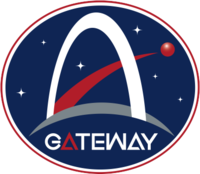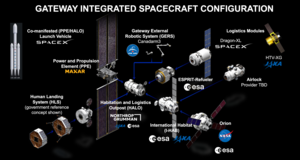The Lunar Gateway is a planned space station that will orbit the Moon. It is part of NASA’s Artemis program and will serve as a staging point for crewed missions to the lunar surface and deeper into space. The Lunar Gateway will provide a platform for scientific research, international collaboration, and sustainable exploration of the Moon.
Subscribe to our weekly newsletter which summarizes all articles from the previous week.
The Lunar Gateway, or simply Gateway, is the first planned extraterrestrial space station. It will be placed in lunar orbit and is intended to serve as a solar-powered communication hub, science laboratory, and short-term habitation module for government-agency astronauts, as well as a holding area for rovers and other robots. It is a multinational collaborative project involving four of the International Space Station partner agencies — NASA, European Space Agency (ESA), Japan Aerospace Exploration Agency (JAXA), and the Canadian Space Agency (CSA) — as well as the Mohammed Bin Rashid Space Centre (MBRSC), which will provide the Crew and Science Airlock module for the Lunar Gateway. The Lunar Gateway is planned to be both the first space station beyond low Earth orbit and the first space station to orbit the Moon.
 An illustration of the Gateway's Power and Propulsion Element (PPE) and Habitation and Logistics Outpost (HALO) in orbit around the Moon in 2025. | |
 | |
| Station statistics | |
|---|---|
| Crew | Max 4 (planned) |
| Launch | November 2025 (planned) |
| Carrier rocket | Falcon Heavy SLS Block 1B |
| Launch pad | Kennedy Space Center Launch Complex 39 |
| Mission status | In development |
| Pressurised volume | ≥125 m3 (4,400 cu ft) (planned) |
| Periselene altitude | 3,000 km (1,900 mi) |
| Aposelene altitude | 70,000 km (43,000 mi) |
| Orbital inclination | Polar near-rectilinear halo orbit (NRHO) |
| Orbital period | ≈7 days |
| Configuration | |
 Configuration as of 16 November 2022 | |
Formerly known as the Deep Space Gateway (DSG), the station was renamed Lunar Orbital Platform-Gateway (LOP-G) in NASA's 2018 proposal for the 2019 United States federal budget. When the NASA budget was signed into law on February 15, 2019, US$450 million had been committed by Congress to preliminary studies.
The science disciplines to be studied on the Gateway are expected to include planetary science, astrophysics, Earth observation, heliophysics, fundamental space biology, and human health and performance. Construction is planned to take place in the 2020s. The International Space Exploration Coordination Group (ISECG), which is composed of 14 space agencies including NASA, has concluded that Gateway systems will be critical in expanding human presence to the Moon, to Mars, and deeper into the Solar System.
The project is expected to play a major role in NASA's Artemis program, after 2024. While the project is led by NASA, the Gateway is meant to be developed, serviced, and utilized in collaboration with the CSA, ESA, JAXA, and commercial partners. It will serve as the staging point for both robotic and crewed exploration of the lunar south pole and is the proposed staging point for NASA's Deep Space Transport concept for transport to Mars.
